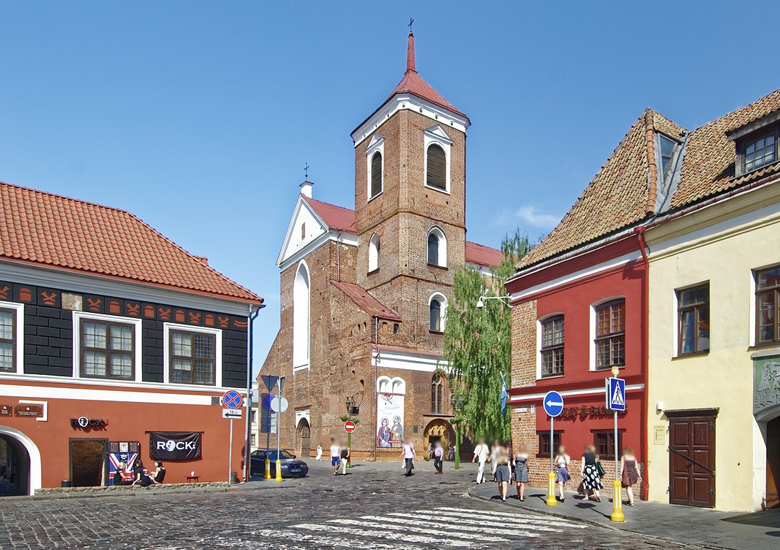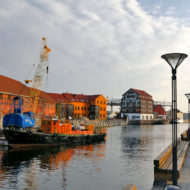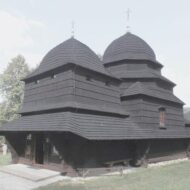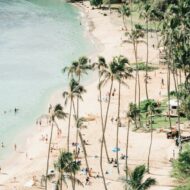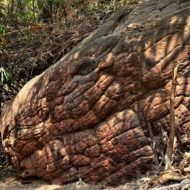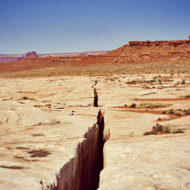Kaunas is the second biggest city in the centre of Lithuania. Understand : Kaunas is Lithuania’s second city with approximately 350,000 inhabitants (2009) in the municipality, but is no way a poor relation. For a time it acted as temporary capital and as such benefited from investment and the status. A visit in February is not everyone’s idea of peak holiday time but it may add to the city’s appeal. Yes it will be -15 degrees C outside, and yes there was snow and ice and it takes 10 minutes to dress before venturing out and another 10 to undress when you go back inside but when else do most of us get to experience that? It’s not like England where one snowflake brings the transport network to a halt. Don’t forget the people of Kaunas are used to it and life goes on with great efficiency.
Museums have cloakrooms, everywhere is well heated and draft proofed, supermarkets have lockers to leave your coats, hats, scarves, gloves, sledges and so on and nobody minds you sipping vodka from a 200 ml bottle to keep your insides warm. As well as the usual attractions this time of year allows you to go sledging or across the bridge to the park on an island in the river to build snowmen, have snowball fights and drag huge chunks of ice up to the bridge to send crashing onto the frozen river below. You will notice that some couples had attached padlocks to the bridge with their names scratched or painted on – a custom one may have observed elsewhere in Eastern Europe. The gist is pretty clear and the bridge to the park is an ideal location to continue. There is a locksmith who sells padlocks in a courtyard off the northern side of Laisves Aleja towards the eastern end – reasonably priced too. Go for the ones with the longest hasp (loop) as the bars of the bridge are really thick. Failing that attach yours to one that is already there! Take a note, that Lithuanian phrasebook is very useful while in Kaunas or other site of Lithuania.
Access : Coordinates: 54.897222, 23.886111 / By plane : Kaunas international airport, (IATA: KUN, ICAO: EYKA) can accommodate planes of practically all types, though recently it is served exclusively by the largest low cost airline in Europe Ryanair. The airport is located 14km /8 miles (~25-30min drive) from the Kaunas downtown and directly linked to the A6/E262 (Kaunas-Daugavpils) highway, which borders airport’s northern boundaries and meets up with A1/E85 motorway at the Murava junction about 7km south from the airport. Kaunas airport has been chosen as first Ryanair base in Central Europe in May 2010. Today it connects Kaunas with Rimini, Birmingham, Bristol, Brussels-South Charleroi, Dublin, Edinburgh, Frankfurt-Hahn, Leeds-Bradford, Liverpool, London-Gatwick, Luton and Stansted, Oslo-Rygge, Stockholm-Skavsta and Tampere.
In summer season there are flights to the Greek islands Kos and Rhodes, Alicante and Mallorca in Spain, as well as Pafos in Cyprus, and Malta. There were some attempts to collaborate with IrAero airlines, some flights between Kaunas and Moscow occurred, however the regular flights were terminated. Since then from time to time on various occasions charter flights are flown.
New modern terminal for passengers was opened in March 2008, the airport itself has been substantially renewed, the works were completed in Nov 2010. There are some vendors in the terminal building, including a restaurant, bars, and duty free shops, as well as car rentals. Travel agency, currency exchange, and ATM services are also available. Airport has 3 parking lots with ~1000 parking spaces offering short- and long-term parking. From the airport a municipality bus #29 – found right outside – takes you into the center of Kaunas, going by route: Kaunas Airport – Karmelava town – (arrives to Kaunas city) – Savanoriu Av – Old Town – Central Bus Station – Central Train Station. Tickets for €1 are available from the driver. Bus timetable is fitted to flight schedule as much as possible.
Note that bus #29 belong to Kaunas municipality bus fleet and is designed to serve exclusively the route between Kaunas centre (train station stop) and Kaunas air port which is in Karmelava town outside Kaunas itself. This bus operates as a regular city bus and stops at all stops enroute, you have to get off where you need to. Schedules are absent on intercity bus timetables, you have to look at Kaunas City bus timetable instead. There are also two regular routes by shuttle bus from Kaunas airport to Vilnius and Klaipeda. There is a taxi stand in front of the airport. A taxi to the Old Town of Kaunas costs around €20. Some Kaunas’ hotels offer a shuttle to/from the Kaunas airport.
Another air port that is 100km away from Kaunas, is Vilnius airport. The airlines that operate from Vilnius airport are AirLituanica, AirBaltic, Aeroflot, Austrian, Avion Express, Brussels Airlines, Estonian Air, Finnair, Grand Cru Airlines, LOT, Lufthansa, Norwegian AirShuttle, Ryanair, Scandinavian Airlines (SAS), Small Planet Airlines, Turkish Airlines, Ukraine International Airlines (UIA) and Wizz Air
By road : Kaunas is served by a number of major Baltic freeways. The international road Via Baltica E67 (connecting Warsaw, to Tallinn) crosses Kaunas at western suburbs Akademija and Silainiai just after about 70km (45 miles) from the Lithuanian-Poland border. It is the most important road connection between the Baltic states. Via Baltica also serves as the Western bypass of Kaunas city. The 311km motorway A1 connects Kaunas with the Baltic seaside in the west (Klaipeda sea port and Palanga resort), and capital Vilnius in the east, with further extention to Minsk, Belarus, via the A2 highway. Intercity buses serve section Kaunas-Vilnius every 30-60 min.
Another important highway A6/E262 that stretches NE and passes the air port, links Kaunas with Jonava, Ukmerge, Utena, and Daugavpils (Latvia). National status roads connect Kaunas with Alytus, Druskininkai and Hrodna (Belarus) in the south, Sakiai, Kybartai and Kaliningrad (Russia) in the south-west, and Klaipeda through Jurbarkas and Silute in the west.
By train : At the Kaunas Railway Station (lith. Kauno gelezinkelio stotis), M.K. Ciurlionio St 16, phone +370 700 55111, there are lockers next to the ticket office, a tourist office, an ATM and a small cafe. There are many trains from Vilnius to Kaunas. If travelling from Klaipeda by train to Kaunas, you must make a stop at Kaisiadorys, and wait for another train running from Vilnius or travel up to Jonava and take a short ride by bus to Kaunas directly. Currently there is no smooth train connection between Klaipeda and Kaunas, the railway line between Kaunas and Jonava is inoperative. There is a train to Poland with a “technical” change at Sestokai (connection always wait). Czech made Double-deck electric trains, alongside with older ones, go from Vilnius to Kaunas, and vice versa. Recently renovated 1.3km (0.8 miles) long Kaunas railway tunnel built between 1859 and 1861 near Kaunas central railway station is worth attention for tourists. It started operations earlier than Underground of London. A restored steam engine stands at the western entrance of Kaunas railway tunnel. There is a lot of “vintage” railway infrastructure objects along the railway in all country, and especially in and around Kaunas at some 50km radius.
By bus : There are some frequent bus routes that radiate out from Kaunas and serve other countries.
By boat : Lithuania’s sea port is Klaipeda on the Baltic sea coast. From there one can rent a car or take a bus to get to Kaunas, which is about 210km (130 miles) inland. There is no railway line from the coast to Kaunas
Get around : Kaunas has well developed public transport system. There are about 17 trolleybus routes and about 50 bus routes within the city limits. Number of routes slightly vary with time. Bus and trolleybus tickets are bought from the driver for cash. The Kaunas Public Transport site offers useful information and a downloadable map of the bus and trolleybus routes. Since 2007 electronic tickets were introduced for public transport in Kaunas, while the paper tickets, which are valid for single journey in Kaunas municipality buses and trolleybuses, can be purchased from drivers only. You must purchase a ticket immediately after boarding the vehicle.
Attractions : Kaunas has several districts and sites interesting for tourists. The Old Town is the area mostly built between XIV and XVII centuries, resembling buildings in Gothic, Renaissance, and, Baroque architecture. Open spaces, parks, and places of interested are in the compact New Town as well as some different locations. A walking tour is the best way to see the Old Town of Kaunas. A lot of guided excursions are available at Kaunas region tourism information office . You can also get a free tour from a local guide (often a student). They take you on a three hour tour, showing you all the popular but also the less known spots and telling loads of funny stories. Afterwards, you can give them a tip (10 litas per person). Kaunas boasts around 40 different museums of art, nature, literature, history, science, and sports as well as historical and memorial museums.
Old Town : The Kaunas Castle – Papilio St 17 Kaunas castle was built in the middle of XIV century and is the oldest building in Kaunas / The Kaunas City Hall – Rotuses sq. 15, built in the middle of XVI century, at the time when Kaunas was flourishing city of merchants / Kaunas Ceramics museum. The museum collection consists of various archaeological findings from the Old Town and surroundings of Kaunas / The City Hall Square – the main square of the Old Town is the place for Kaunas City Hall and the surrounding buildings with lots of restaurants, bars, coffee-houses, museums, art galleries, and, hotels nearby /
Wax Melting Furnace – the unique exposure of XV century wax melting stove near the Tower entrance of the City /
The Communications History Museum – Rotuses sq. 19; The museum houses the collection of unique and still working exhibits, and offers visitors to familiarize themselves with the history of development of post, as well as others means of communications. / Maironis Museum of Lithuania Literature – Rotuses sq. 13 museum located in Baroque palace, has been arranged as a memorial home of famous Lithuanian poet and priest Maironis /
Kaunas Arch-cathedral Basilica – Vilniaus str. 1 being 84 m long and 34 m wide is the largest Gothic (with Renaissance and Baroque elements inside) church in Lithuania. It was first mentioned in writing sources in 1413 /
Kaunas Medicine and Pharmacy Museum – Rotuses sq. 28. Houses a huge collection of skulls, herbs, medicine articles, and, other stuff of older times. Open 10 AM -7 PM daily. Mon. closed. Tickets: 3 LTL for adults, 1,5 LTL for childs. Excursions in English are available (price ~€10) /
St. Francis Xavier Church – Rotuses sq. 9. The construction of late baroque Jesuit church was begun in the second half of the XVII century but finished only in 1720 /
Vytautas’ Church – Aleksoto str.3 officially named The Church of Taking Holy Virgin Mary into the Heaven church is the oldest one in Kaunas and is one of the first Gothic brick buildings built in 1400 in Kaunas on the bank of the Nemunas river /
Vytautas’ Bridge – connects the Old Town and Aleksotas district. The original bridge on wooden poles was built in 1812 /
Evangelic Luteran Church – Karaliaus Mindaugo av. 3; a small church located on the right bank of the Nemunas river in so called Germans quarter of the Old Town is in Baroque and Romanticism styles. The church was built in 1682 – 1683 /
St. Gertrude Church – Laisves aleja 101A; the church was built in the late XV century. It is a small sacral building in the outskirts of the Old Town in one of the courtyards, a national architectural monument of Gothic style. /
Napoleon’s House – Muitines str. 8; the brick building of the XVI century is famous for a fact that in June of 1812, the Emperor of France Napoleon resided there. Later the building was named after its distinguished guest /
Church of Holy Trinity – Rotuses sq. 22; the Bernardine convent’s church was built in 1624-1634. It is of late Renaissance style with a Gothic tradition. At the moment, it is used for needs of Kaunas Priest Seminary.
St. George Church and Bernardine Monastery – Papilio str. 7; located near Kaunas Castle, church’s Gothic walls have survived despite frequent fires. The church and a monastery built in XV century are a Gothic monument with unique facades. /
Perkunas’ House – Aleksoto str. 6; one of the most beautiful secular so called “flaming” Gothic building (House of Thunder) in Lithuania. /
St. Michael Church and Benedictine Convent – Benediktiniu str. 8 the church is a fine example of 15th century Gothic sacral building that is only with asymmetric layout in Lithuania. /
Jewellery (Gemmology) Museum – L. Zamenhofo str./Kurpiu str. 13 located between the Nemunas river and the main – Vilniaus street of the Old Town, small private museum attracts visitors with rare minerals, precious stones exposition from different locations of the world. Quality certificates of precious stones and gems are issued there. Open: Mo-Fr 10AM-6PM; Sa 10AM-4PM. Entrance €5. /
Historical Presidential Palace – Vilniaus str. 33; Former Palace houses objects, which relate to presidential institution of the First Republic of Lithuania (1918–1940). /
Central Kaunas : Kaunas downtown area is compact so everyone is able to stroll around on foot and take some photos. Be prepared for great variety of sculptuary on display in the public areas of Kaunas. Kaunas Old Town ends at the remnants of the former Kaunas City wall near the garden of the Musical Theatre.
Laisves aleja – Kaunas’ most famous walking street is fully pedestrianised and runs from the Old Town for a distance of almost 2 km to the Church of St. Michael the Archangel. Two lines of Linden trees, seating and flower beds run the length of the avenue. There is a good assortment of shops, banks, supermarkets, restaurants, a cinema, casinos, nightclubs, museums, tourist information office, places to stay and a central post office. It would be possible to spend your entire stay on Laisves Aleja and not get bored. It is kept clean and snow free (in the winter) with great efficiency and is a great place to spend time. In the late morning and afternoon various stalls selling foods, souvenirs hats etc. appear and are worth a look.
The Field of Victims – the memorial in Laisves aleja near the garden of the Musical theatre was unveiled on 14 May, 2002. It was dedicated to Romas Kalanta, who self-immolated himself protesting the Soviet oppresion on 14 May, 1972. /
Vytautas’ Monument – located on Laisves aleja, near the Kaunas city municipality building. The monument to Vytautas the Great – the most famous ruler of medieval Lithuania was erected in 1930. It was demolished by the Soviets and then re-erected in 1990 /
The Synagogue – E. Ozeskienes str. 13. Kaunas Choral Synagogue / Tadas Ivanauskas Zoological Museum – Laisves aleja, 106. Houses a collection of thousands of stuffed and preserved animals. In winter make use of the cloakroom to the left of the main hall on the ground floor as the museum is well heated /
The Catacombs – enter the Church of St. Michael the Archangel (the beautiful domed building at the eastern end of Laisves Aleja) sand the entrance to the catacombs (katakombos) is on your right. Ask at the sacristy (right of the main altar) and they will let you in for free. /
Vytautas the Great War Museum – K. Donelaicio str. 64. An interactive exposition of history of Kaunas from prehistoric times to the present day. / The Tomb of the Unknown Soldier and Eternal flame – both in the square in front of Vytautas the Great Museum with the statues of Lithuanian national renaissance figures and the are located. /
The Carillion – Kaunas 35 bell Carillon in the tower of Vytautas the Great War Museum was completed in Belgium in 1935. / The Bank of Lithuania – Maironio str.25 the branch of Lithuania National bank in Kaunas. It was built in 1928 as a new Central Bank building /
M. K. Ciurlionis National Art Museum – V. Putvinskio str. 55. Museum collects, keeps, investigates and popularizes Lithuanian most famuous artist and composer’s M. K. Ciurlionis’ (1875–1911) creative works, cultural heritage of Lithuania and the world. Some art critics call M. K. Ciurlionis the pioneer of abstract art. His creations combine symbolism, secessio, abstractionsism and romanticism. Working hours: October – May: Tu – Su 11AM–5PM. June – September: Tu–Su 10AM–5PM. Tickets: €4 for adults, €2 for students & seniors, free for people with disabilities or seniors over 80 /
Devils’ Museum – V. Putvinskio str.64. Contains the Lithuanian artist’ A. Zmuidzinavicius collection of sculptures and carvings of devils, and a unique collection of devils from the whole world. Tel: + 370 37 221 587′ Open Tu-Su 11AM-5PM, Thu 11AM-7PM. Tickets €3, guided tours available. /
Kaunas Picture Gallery – K. Donelaicio str.16. Gallery houses XX century Lithuanian and Lithuanian emigres art, and a collection of North American Indian art donated by Juozas Kaributas (the USA). There is also Jurgis Maciunas FLUXUS cabinet and Art Collection of prof. Algimantas Miskinis. Open Tu-Su 11AM-5PM. Ticket price 4 LTL (€1,2). /
Funicular railways – There are two still functioning funiculars in Kaunas. The Zaliakalnis Funicular on V. Putvinskio street is an electrically operated funicular railway. /
The Nemunas Island Park (Nemunos salos parkas), accessed across a footbridge at the southern end of S. Daukanto pedestrian street. A huge open space minutes from the bustle of Laisves Aleja. A great place to sledge when there is snow and of course the place to leave your padlocks. / Kaunas Orthodox Cathedral – Vytauto av. 38. Orthodox the Annunciation Cathedral, as well as smaller Orthodox church located nearby, forms unanimous complex in the southern part of Ramybes park near Vytauto avenue. The new Orthodox Cathedral was built in 1935 and represents the variety of consequences of traditional forms of Russian Orthodox churches. Smaller – Holy Resurrection Orthodox church was constructed in 1862 on the area of the local Orthodox cemetery and since 1923 till 1935 acted as Lithuanian Orthodox Cathedral. Entrance free. /
The Mosque – Totoriu St 3. The only in Lithuania Eastern style building and mosque of bricks located in the northern corner of the Ramybe Park of Kaunas downtown / Museum of Deportation and Resistance – Vytauto av. 46. One of five divisions of Kaunas City Museum. Resistance and Deportation Exhibition is sacred to the memory of victims of Soviet regime and Forest Brothers who fought for Freedom of Lithuania /
Other Sights :
Christ’s Resurrection Church, follow V. Putvinskio street from the Devil Museum or walk up behind the War Museum and turn right to find the Zaliakalnis Funicular Railway /
The House of Sugihara – Vaizgantas St 30. The memorial exhibition located in quiet residential area of Zaliakalnis is functioning in the building where before World War II, The Japanese consulate’s vice-concul Chiune Sugihara resided /
Azuolynas Park – named after the old Oak-wood tree park, it is in Zaliakalnis residential district easily reachable from the downtown area by some staircases or buses #6,10,21,37 (from K. Donelaicio str.) or #38,43 (from Vytauto av.). / Lithuanian Zoo Park – the only Zoo garden in Lithuania was established in a Azuolynas park, in which grow hundred year old oaks near the city center in 1938. It is made up of 11 sections and offers 6 classes of animals. Children may ride a pony, a donkey, or take a ride in a horse drawn carriage. Working hours 9AM-7PM. Tickets: May-October ~€3.5 for adults & ~€2.5 for pupils, November-April €2 for adults & €1.5 for pupils. /
Lithuania’s Museum of Aviation– Veiveriu St 132. Museum is in Aleksotas district, at the former S. Darius and S. Girenas international airport of Kaunas. / Kaunas Botanical Garden – Z. E. Zilibero str. 6; the Garden is one of the most beautiful sites of nature in Kaunas comprises the area of 62.5 hectares with greenhouses founded in 1923. The Labyrinthes, little zoo, mythological track, and car parking are also attainable at the Garden. /
Napoleon’s Hill – actually the Jiesia river hill, located on the left bank of the Nemunas river, between the Panemune residential neighborhood and so called Green Railway bridge. Since the early XIX century it has been nicknamed Napoleon’s hill. It is believed that from this hill in June 1812 Emperor of France Napoleon I watched his Grand Army crossing the Nemunas. The hill is accessible from the Kaunas castle by bus #25 or taxi. /
Kaunas Fortress – built between 1882 and 1915, it was designated a “first-class” fortress in Russian Empire in 1887. / 9th Fort Museum [28] – Zemaiciu av. 73 located in a park of the western outskirts of Kaunas. /
Pazaislis Monastery and Church – form the largest monastery and church complex in Lithuania,
Activities : Lovers of nightlife may enjoy Kaunas’s theatres, nightclubs, cafes and bars, offering a wide range of entertainment, including casinos, striptease, local and foreign DJs, or, for instance, basketball/football games translations on large screens.
Festivals
Kaunas is home to a variety of festivals, including famous summer time Pazaislis Music festival , Kaunas Jazz festival (at the end of April/ begininng of May) and International Modern Dance Festival (September – October). All year round in Kaunas one will have an opportunity to see some annual cultural events like Kaziukas Fair (at the beginning of March), Kaunas City Days (20 May and the closest weekend to this date), National Brass Band Festival Let’s pipe for Kaunas in the squares of the city (on May 21), International auto-moto fan fiesta Bike Show Millenium attracts huge amount of bikers and their bikes in the middle of June, Operetta in Kaunas Castle (at the end of June and the beginning of July) or traditional folk music competition Play, Jurgelis (in November). Kaunas is proud of being the only city in Lithuania that belongs to the international towns’ union The New Hansa. Every year, Kaunas presents itself at the annual event of the union International Hansa Days by introducing the heritage of cuisine, folk art, medieval music and theatre; Hansa Kaunas festival is usually held in the last decade of August. The shopping festival Akropolis Kaunas Grand Shopping Festival is held in the first decade of July at Kaunas Akropolis shopping center. During the festival, the great discounts apply to all goods in all stores of the shopping center
Beaches :
There are some beaches on the banks of Nemunas river, shores of Lampedziai lake and Kaunas Reservoir. Beaches are open in summer time.
Panemunes Park Beach is in the loop of Nemunas river on the shore of the brilliant Panemune Park. The beach is easily reachable on foot if start from shopping center “Molas” (K. Barsausko str.), you should go by A. ir J. Gravrogku str. and then by pedestrian bridge across the Nemunas river or by car or taxi from the city center. It‘s a popular place to visit.
Lampedziai Lake Beach is set in the western part of Kaunas. It is a small lake surrounded by Lampedziai park that attract a lot of locals in summer time. Beach is reachable by car, taxi, or buses #48 (runs from Kaunas castle bus stop) or #9 (runs from Silainiai residential district).
Kaunas Reservoir Beach is situated on the shore of Pazaislis park near Pazaislis church and monastery ensemble. The water is almost the purest of all Kaunas beaches. Beach is reachable by car, taxi, or trolleybuses #9 or 12 (summer time only). Kaunas Reservoir is the largest Lithuanian artificial lake, created in 1959 by damming the Nemunas river near Kaunas and Rumsiskes. The reservoir supports the operations of the Kaunas Hydroelectric Power Plant. The reservoir also supports the operations of Kruonis Pumped Storage Plant, which is situated near confluence of Reservoir with small Streva river, at distance of about 25 kilometers east from Kaunas.
Go next : Birstonas / Rumsiskes / Zapyskis / Druskininkai




